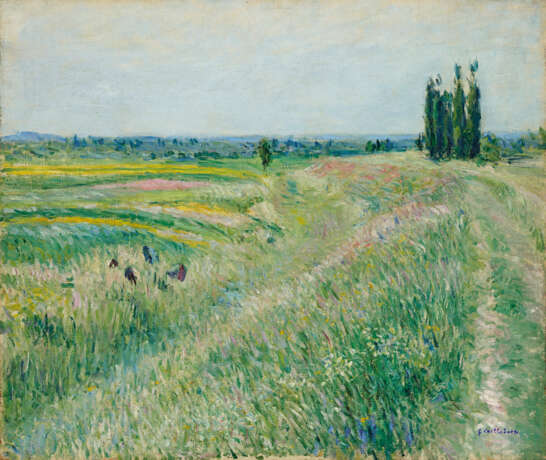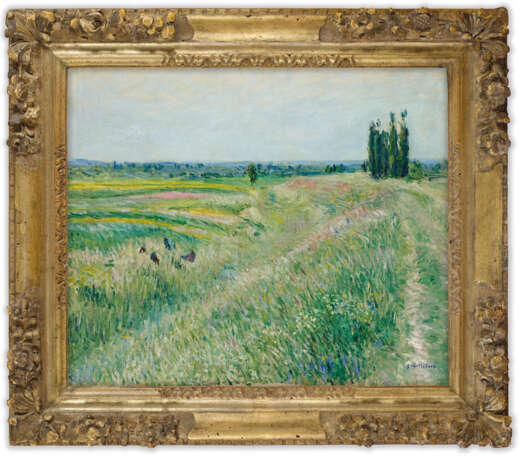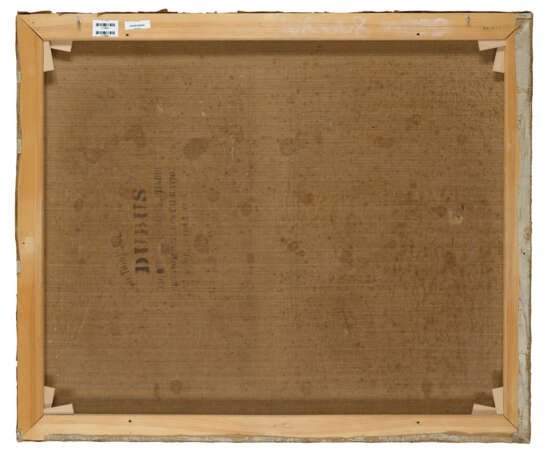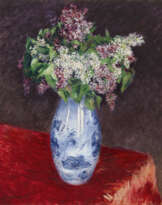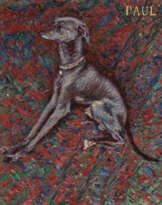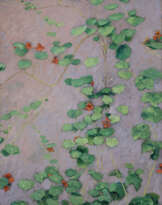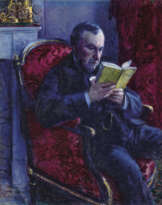ID 1051686
Lot 121 | Gustave Caillebotte (1848-1894)
Estimate value
€ 350 000 – 550 000
La Plaine de Gennevilliers, groupe de peupliers
avec le cachet 'G. Caillebotte.' (en bas à droite)
huile sur toile
54.1 x 65.1 cm.
Peint vers 1883
stamped 'G. Caillebotte.' (lower right)
oil on canvas
21 ¼ x 25 5⁄8 in.
Painted circa 1883
Provenance
Galerie Renou, Paris.
Walter Feilchenfeldt Kunsthandel, Zurich.
Sam Josefowitz, Pully (acquis auprès de celle-ci le 10 septembre 1986).
Puis par descendance aux propriétaires actuels.
Literature
M.-J. de Balanda, Gustave Caillebotte, La vie, La technique, L’œuvre peint, Lausanne, 1988, p. 150-151 (illustré en couleurs; inversé ; titré ‘Champs jaunes à Gennevilliers’).
P. Bachelard, dir., De Manet à Caillebotte, Les impressionnistes à Gennevilliers, Paris, 1993, p. 63 (illustré en couleurs; titré ‘Champs au Petit-Gennevilliers’; daté ‘vers 1884’).
M. Berhaut, Gustave Caillebotte, Catalogue raisonné des peintures et pastels, Paris, 1994, p. 174, no. 269 (illustré).
Exhibited
Vikersund, Stiftelsen Modums Blaafarveværk, Somrene i Normandie, Fra Monet til Strindberg og Thaulow, avril-octobre 1994, p. 72, no. 38 (illustré en couleurs, p. 73; daté '1884').
Tokyo, Bridgestone Museum of Art, Ishibashi Foundation, Gustave Caillebotte Impressionist in Modern Paris, octobre-décembre 2013, p. 151 et 265, no. 48 (illustré en couleurs, p. 151).
Washington, National Gallery of Art et Fort Worth, Kimbell Art Museum, Gustave Caillebotte, The Painter's Eye, juin 2015-février 2016, p. 225, no. 52 (illustré en couleurs; daté '1884').
Giverny, Musée des Impressionnismes et Madrid, Museo Thyssen-Bornemisza, Caillebotte, Peintre et jardinier, mars-octobre 2016, p. 150, no. 44 (illustré en couleurs, p. 93).
Further details
En 1881, Gustave Caillebotte et son frère Martial achètent une propriété dans le petit village du Petit Gennevilliers, de l’autre côté de la Seine, face à Argenteuil. Caillebotte était un navigateur passionné et la présence du club nautique du coin, le Cercle de la Voile de Paris, était un élément déterminant lors de son choix. Son achat était également une réponse à sa désillusion croissante face à la vie parisienne. Le conflit interne entre ses pairs impressionnistes l’a poussé à quitter son poste d’organisateur de la septième exposition du groupe en 1882, qui a alors été organisée par Durand-Ruel, le marchand d’art des Impressionnistes. Caillebotte s’est définitivement installé au Petit Gennevilliers en 1887.
La maison et les jardins de Caillebotte, ainsi que leurs environs, étaient une source intarissable d’inspiration pour l’artiste. Le nombre important de paysages peints après 1881 révèle à quel point il appréciait la beauté de cet endroit. Peignant directement ce qu’il voyait dans la nature, sa technique est devenue beaucoup plus impressionniste et son application de la peinture plus riche. La composition de La Plaine de Gennevilliers, Groupe de peupliers est organisée autour d’une structure au sein de laquelle une ligne horizontale raide est ravivée par des éléments diagonaux et verticaux prononcés, qui n’est pas sans rappeler ses paysages parisiens antérieurs. Un autre élément qui nous rappelle cela est l’impression d’un point de vue en hauteur. Dans ses compositions représentant Paris, cela était utilisé pour éliminer l’espace en évitant de représenter l’horizon. Ici, l’artiste utilise cette technique afin d’éliminer tout obstacle à l’horizon, créant ainsi un vaste panorama étendu. La structure de la composition de cette œuvre est fondée sur le recul du paysage. Les plaines autour du Petit Gennevilliers servaient à la culture du maïs, de l’orge et de la luzerne. Caillebotte a peint six autres paysages de la plaine en deux ans et les variations de couleurs reflètent les différences saisonnières dans l’agriculture. La Plaine de Gennevilliers, Groupe de peupliers est le seul tableau de cette série sur lequel figurent les peupliers – un sujet emblématique dans l’impressionnisme – servant à amplifier le recul de l’espace dans le paysage.
In 1881, Gustave Caillebotte and his brother Martial bought property in the small village of Petit Gennevilliers across the river from Argenteuil in Normandy. Caillebotte was an avid yachtsman and the presence of the nearby sailing club, Cercle de la Voile de Paris, was an important factor in making his choice. The timing of his purchase was also a response to his growing disillusion with Parisian life. The infighting among his fellow Impressionists culminated with his resignation as organizer of the group's seventh exhibition in 1882, which was then assembled by Durand-Ruel, the Impressionists' dealer. He settled permanently in Petit Gennevilliers in 1887.
Caillebotte's home and gardens, as well as its surroundings provided the artist with a rich source of subjects for his painting. His appreciation of the beauty of the area is made clear by the substantial number of landscape subjects he painted after 1881. Painting directly from nature, his technique became more impressionistic and his application of paint became thicker and richer. In a manner reminiscent of his earlier Parisian views, the composition of La Plaine de Gennevilliers, Groupe de peupliers is built around a framework where a rigid horizon line is animated by strong diagonal and vertical elements. Another factor that recalls the Parisian views is the sense of an elevated viewpoint. In his Parisian motifs, this trope was used to nullify space by avoiding a depiction of the horizon. In the present work, it is used to eliminate any obstruction to the horizon, creating a vast, sweeping panorama. The structure of the composition of the present work is based around the recession of the landscape. The landscape around Petit Gennevilliers were agricultural fields of corn, barley and alfalfa. Caillebotte painted six other views of this plain over the course of two years and the variations of color reflect the seasonal differences in cultivation. La Plaine de Gennevilliers, Groupe de peupliers is the only one of this series to include the poplar trees – an iconic impressionist subject – as a device to emphasize the depth of the landscape's perspective.
| Artist: | Gustave Caillebotte (1848 - 1894) |
|---|---|
| Applied technique: | Oil on canvas |
| Auction house category: | Paintings |
| Artist: | Gustave Caillebotte (1848 - 1894) |
|---|---|
| Applied technique: | Oil on canvas |
| Auction house category: | Paintings |
| Address of auction |
CHRISTIE'S 9 Avenue Matignon 75008 Paris France | ||||||||||||||
|---|---|---|---|---|---|---|---|---|---|---|---|---|---|---|---|
| Preview |
| ||||||||||||||
| Phone | +33 (0)1 40 76 85 85 | ||||||||||||||
| Fax | +33 (0)1 40 76 85 86 | ||||||||||||||
| Conditions of purchase | Conditions of purchase | ||||||||||||||
| Shipping |
Postal service Courier service pickup by yourself | ||||||||||||||
| Payment methods |
Wire Transfer | ||||||||||||||
| Business hours | Business hours
|
